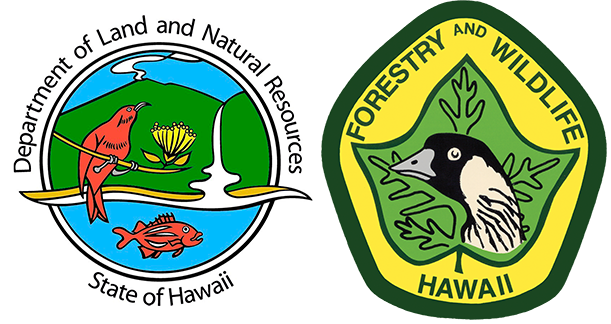Help Protect Hawai‘i’s Seabirds — Turn Off Unneeded Night Lights and Look Out for Downed Seabirds
Posted on Nov 15, 2017DEPARTMENT OF LAND AND NATURAL RESOURCES
News Release
| DAVID Y. IGE GOVERNOR |
SUZANNE D. CASE
CHAIRPERSON |
For Immediate News Release November 15, 2017

HELP PROTECT HAWAII’S SEABIRDS — TURN OFF UNNEEDED NIGHT LIGHTS
AND LOOK OUT FOR DOWNED SEABIRDS
HONOLULU — It’s Fall in Hawai‘i, and once again time to watch out for the “fallout” of young seabirds on our islands. At this time of year, native Hawaiian seabirds become disoriented by artificial lights during their maiden flights from their burrows out to sea.
Hawaiian seabirds have an important role to play on our islands. They were traditionally used by navigators to find their way back home to their islands; they help our fishermen to locate schools of ahi; and are critical to our watersheds by helping to fertilize the soils with marine nutrients in their droppings. Each year people pitch in to help these birds by turning their lights down and rescuing birds when they are found.
Hawai‘i’s small land area and increasing human development have left many of our native birds in a tough situation. Seabirds in particular have run into trouble when chicks take their first flight out to sea. As they rely on the light of the moon to guide them out to sea, they may be attracted to, and disoriented by onshore sources of man-made light. Individual young birds will circle these lights until they eventually fall to the ground from exhaustion, or from colliding with buildings or vegetation.
This occurrence is often referred to as “fallout” and it occurs primarily between September and December each year. When grounded, these birds are at risk of predation by cats, mongoose and other predators, vehicle collisions, and starvation. Fallout birds are often seen landing or sitting on roadways, parking lots, and lawns.
To help decrease this substantial problem, the DLNR Division of Forestry and Wildlife is urging communities to watch out for and help with the rescue of these young seabirds. But there’s more that can and needs to be done:
Homeowners and businesses can make a significant positive impact on the lives of our native seabirds, and save thousands of dollars in energy costs, by taking simple and focused steps to manage outdoor lighting between September 15 and Dec. 15. Businesses and homeowners are encouraged to do the following:
- turn all outdoor lights so that they are facing down to the ground, and use downward lighting for signs;
- turn off decorative and unnecessary lights as much as possible;
- replace bare spotlights, floodlights, and unshielded lights with seabird friendly lighting styles (including shielding the lights to prevent them from facing upwards and using non-white or lower wattage lamps);
- place floodlights and security lights on motion detectors so that they are not on all the time;
- shield outdoor lights with commercially available or home-made glare reducing shields;
- close curtains at night to help reduce overall glow and glare; and
- keep dogs and cats indoors so that they are not able to attack and kill grounded birds outside
For illustrations and guidance related to seabird-friendly light styles that also protect the dark starry skies of Hawai‘i visit the the Division of Forestry and Wildlife (DOFAW) website: https://dlnr.hawaii.gov/wildlife/files/2016/03/DOC439.pdf
The public is asked to be on the watch for young seabirds especially the threatened and endangered species such as Newell’s shearwaters (A‘o) and Hawaiian petrels (Ua‘u), as well as the more common Wedge-tailed shearwater (Ua‘u kani).
Wedge-tailed shearwater chicks that are found outside burrows on coastal trails and beaches should be left in place unless there is imminent danger of harm due to dogs, cats or some other activity. These chicks, prior to their first flight, will normally sit outside their burrows exercising and imprinting on their natal area before leaving the nest. It is important that the public realize that these birds are not lost, abandoned, or injured. If you have questions about a Wedge-tailed shearwater, please call the DOFAW Office.
Anyone finding a fallen or injured seabird is asked to do the following:
- Determine if it needs to be rescued
- Often young birds stay near their nest burrows and do not need intervention. These birds will not need to be rescued and should be left alone. If you are uncertain of whether the bird needs help, please call the Division of Forestry and Wildlife or Hawaii Wildlife Center for assistance.
- if a bird is found unresponsive or in an unsecure environment (i.e. side of the road, next to a building, etc.), it needs to be rescued.
- Find and prepare an appropriate sized, well ventilated carrier (air holes)
- Place a clean, soft cloth at bottom of carrier, such as a T-shirt
- With caution, approach bird from behind and use a lightweight towel to gently pick it up and transport it to the carrier.
- Place the container in a quiet and dark place, away from people, animals, and loud noises
- DO NOT give food or water to the bird and do not leave any in the container.
- Note the time and location of where you found the bird.
- Transport the bird to a designated drop off location if available, licensed wildlife rehabilitation facility or any veterinary clinic as soon as possible. See island-specific contact information and licensed rehabbers https://dlnr.hawaii.gov/wildlife/downed-wildlife-contact-details/.
- Birds can be held overnight if transportation to a drop off location is not immediately available. Keep the carrier inside or in an enclosed garage away from people and animals until it can be transported.
For more information, please visit our website: https://dlnr.hawaii.gov/wildlife/seabird-fallout-season/.
# # #
Media Contact:
Deborah Ward
Public Information Specialist
(808) 587-0320
